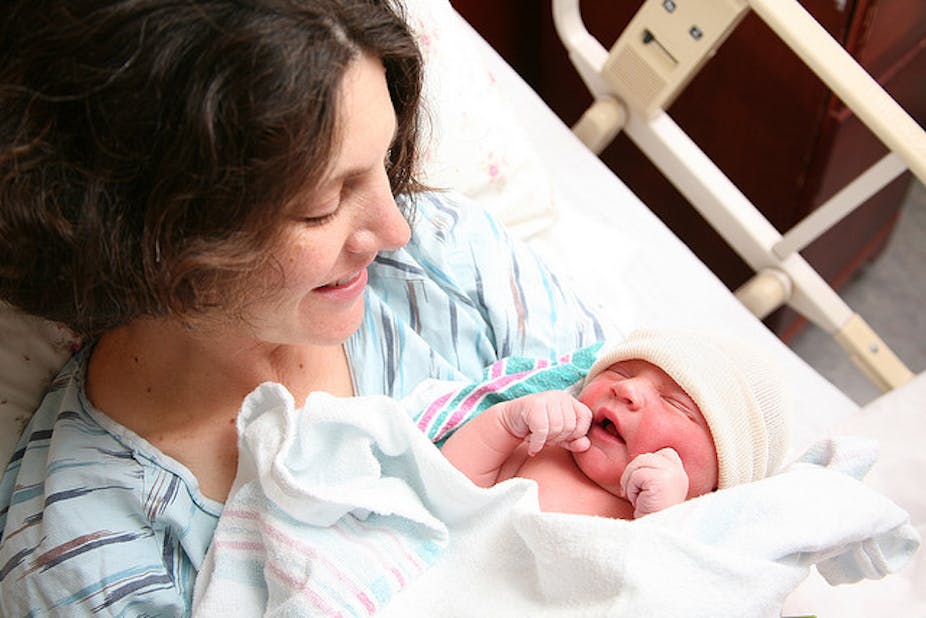There’s no doubt that caesarean sections are an essential procedure that can save the lives of women and babies. But around one in three Australian women will give birth by caesarean section – and that’s not just to save lives.
The problem is that once a procedure becomes this prevalent, there’s a risk it will become normalised as the usual way to give birth. And we certainly haven’t reached a point where one in three women needs a surgical procedure to deliver her baby.
The rising caesarean section rate in most of the developed world has not resulted in reduced rates of stillbirth or infant death – quite the contrary.
One Australian study showed that babies were more likely to be admitted to a neonatal intensive care unit if they were born by elective caesarean section than other types of delivery. A previous caesarean section also increases the risk of stillbirth.
In terms of outcomes for women, those who have emergency and elective cesarean sections are less likely to exclusively breastfeed. And there is growing evidence that caesarean operations increase the risk of the mother dying or becoming ill with blood loss, blood clots, abdominal organ injury and the need for a hysterectomy.
It’s important to consider the risks of caesarean births. But rather than just focus on the polarised “vaginal birth vs caesarean birth” debate – which pitches doctors against midwives, and doesn’t help women who are stuck in the middle – we need to focus on the ways we can support all women to have the best outcome from childbirth.
It seems that one of the driving forces behind the rising caesarean section rate is fear – from other women about labour and birth, and from doctors and midwives who are themselves fearful of the birthing process.
Rather than design studies that compare a fundamentally normal experience with a surgical procedure, we should be examining why women are fearful of labour and birth and what our health system can do to reduce this fear.
Our health system is generally an unfriendly one for pregnant women and it’s likely that this compounds the fear of birth. It’s common for a pregnant woman receiving care in the public system to see up to 30 different caregivers through pregnancy, labour and birth and the postnatal period.
The opportunity for pregnant women to develop a meaningful relationship with her health care provider, discuss her fears, affirm her needs and develop confidence in labour and birth are minimal.
Even in the private sector, a woman will generally know their obstetrician (unless she/he are off call that weekend), but she will meet a multiple of midwives and nurses through labour and the postnatal time.
The birthing environment impacts on women’s capacity to give birth and may contribute to her fear. Birth is a powerful event for women, and memories and perceptions last decades.
One of the disturbing elements of birth in the 21st century is the lack of respect for privacy for labouring women. The entourage of people appearing uninvited into labour rooms in most hospitals is astonishing. Each labour and birth can have a multitude of spectators, including a midwife, obstetrician, registrar, resident, student midwife, medical student and on it goes.
The response to high caesarean rates in some countries, such as Finland, has been to establish “fear clinics” to address the underlying cause of childbirth fear and identify means for women to cope with it, rather than opting for a cesarean section.
To address this problem and encourage Australian women to give birth normally, many states in are embarking on impressive campaigns. In NSW, the Towards Normal Birth Policy was released last year and provides 10 steps towards supporting more women to go into labour and ultimately have a normal birth.
The policy recognises that “some women will have, or develop, certain risk factors that require attention. But unnecessary interference in the natural process may disturb the expected course and may lead to a cascade of intervention.”
The challenge is to redesign the health system to facilitate women’s confidence and trust in birth. Fundamental changes need to occur to ensure all women are supported during pregnancy and feel confident in their ability to give birth, including:
Continuity of caregiver;
Increased options for the style of birth, with access to a birthing pool;
A positive environment, free of disruptions; and
One-to-one midwifery care in labour so women are never left alone or fearful.
I welcome research that seeks to improve outcomes and experiences for birthing women. But rather than study what happens to women who choose childbirth with intervention, let’s concentrate on supporting women to give birth normally without fear.

